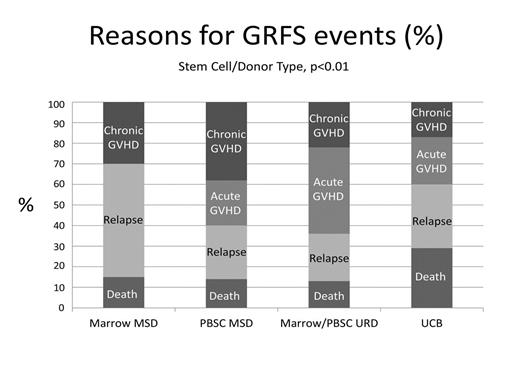Abstract
The success of allogeneic hematopoietic cell transplantation (HCT) is typically assessed by the rates of individual complications of graft–versus-host disease (GVHD), relapse, or death, yet each of these add to overall morbidity. We examined a novel composite endpoint of GVHD-free/relapse-free survival (GRFS) where events include grade III-IV acute GVHD, chronic GVHD requiring systemic treatment, relapse, or death in the first year after HCT. GRFS measures freedom from ongoing morbidity and therefore represents full recovery following HCT. In this analysis, we examined clinical factors influencing GRFS, including year of HCT, age, disease, conditioning regimen intensity, donor type, and graft source. In 907 consecutive University of Minnesota pediatric and adult allogeneic HCT recipients treated from 2000 to 2012, 1-year GRFS was 31% (95% CI 28-34%), but significantly improved over time (2008-2012 relative risk [RR] 0.7, 95% CI 0.6 – 0.9, p<0.01, vs. 2000-2007). Regression analyses modeled over time demonstrated that age, disease risk, and donor type significantly impacted GRFS (Table). Adults age 21+ had a two-fold worsening of GRFS (RR 2.2, 95% CI 1.7 – 2.8, p<0.01) vs. children, but no fall in GRFS from age 21-50+ years was noted (1 year GRFS 20-27%). Standard risk hematologic malignancies had 35% 1 year GRFS; high risk were 30% worse (22%, RR 1.3, 95% CI 1.1 – 1.5, p<0.01). Adjusted for conditioning intensity, stem cell source, disease risk, age, and year of transplant, HLA-matched sibling donor (MSD) marrow grafts resulted in the best GRFS (Figure 1) while peripheral blood stem cells (PBSC) from MSD were significantly worse. GRFS after umbilical cord blood (UCB) and marrow from matched unrelated donors ([URD] were similar to each other, but worse than MSD marrow. Conditioning intensity did not impact GRFS (29% myeloablative, 33% reduced intensity, p=0.5). Among factors that impact GRFS, the stem cell source is potentially modifiable. The improved GRFS with MSD marrow grafts predominantly reflects less morbidity of GVHD (Figure 2). For patients without a MSD, grafts from UCB are equivalent to marrow from URD. GVHD prophylaxis is also a modifiable factor that could impact GRFS, although the choice of prophylaxis regimen was linked to underlying disease and stem cell source and thus not an independent factor in this series. The use of GRFS as a novel endpoint used to capture overall morbidity after HCT may provide a better global comparison of outcomes across different HCT platforms. GRFS has improved over time, although not by any single type of adverse failure event. Using this new GRFS endpoint, 31% of all patients, and only 24% of adults over age 50, survived to 1 year without experiencing one of these major complications. With less than one-third of HCT recipients achieving GRFS, these findings highlight the importance of identifying novel methods of improving upon all these adverse failure events. Each reason for failure can be studied, and all can be improved.
Multiple regression analysis on overall survival
| Factors . | . | N . | RR of GRFS (95% CI) . | Overall P . | P-Value . |
|---|---|---|---|---|---|
| Conditioning | MA | 494 | 1.0 | ||
| RIC | 413 | 0.9 (0.8-1.1) | 0.53 | ||
| Donor Type | Marrow MSD | 53 | 1.0 | 0.01 | Reference |
| PBSC MSD | 269 | 1.8 (1.1-2.9) | 0.02 | ||
| Marrow/PBSC URD | 73 | 1.8 (1.1-3.1) | 0.03 | ||
| UCB | 512 | 1.8 (1.2-2.9) | 0.01 | ||
| Age | 0-20 | 220 | 1.0 | ||
| 21+ | 687 | 2.2 (1.7-2.8) | <0.01 | ||
| Disease Risk | Standard risk | 590 | 1.0 | ||
| High risk | 317 | 1.3 (1.1-1.5) | <0.01 | ||
| Year of HCT | 2000-2007 | 558 | 1.0 | Reference | |
| 2008-2012 | 349 | 0.7 (0.6-0.9) | <0.01 |
| Factors . | . | N . | RR of GRFS (95% CI) . | Overall P . | P-Value . |
|---|---|---|---|---|---|
| Conditioning | MA | 494 | 1.0 | ||
| RIC | 413 | 0.9 (0.8-1.1) | 0.53 | ||
| Donor Type | Marrow MSD | 53 | 1.0 | 0.01 | Reference |
| PBSC MSD | 269 | 1.8 (1.1-2.9) | 0.02 | ||
| Marrow/PBSC URD | 73 | 1.8 (1.1-3.1) | 0.03 | ||
| UCB | 512 | 1.8 (1.2-2.9) | 0.01 | ||
| Age | 0-20 | 220 | 1.0 | ||
| 21+ | 687 | 2.2 (1.7-2.8) | <0.01 | ||
| Disease Risk | Standard risk | 590 | 1.0 | ||
| High risk | 317 | 1.3 (1.1-1.5) | <0.01 | ||
| Year of HCT | 2000-2007 | 558 | 1.0 | Reference | |
| 2008-2012 | 349 | 0.7 (0.6-0.9) | <0.01 |
Kaplan-Meier estimate of GRFS based upon donor type, adjusted for conditioning intensity, stem cell source, disease risk, age, and year of transplant.
Kaplan-Meier estimate of GRFS based upon donor type, adjusted for conditioning intensity, stem cell source, disease risk, age, and year of transplant.
No relevant conflicts of interest to declare.
Author notes
Asterisk with author names denotes non-ASH members.



This feature is available to Subscribers Only
Sign In or Create an Account Close Modal